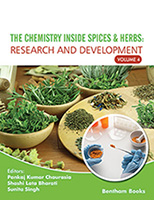Spices and culinary herbs have been in use since ancient times for medicinal purposes. With time many of them have emerged as effective herbal remedies against acute and chronic diseases. Culinary, recreational, and medicinal uses of spices and herbs has triggered vigorous scientific research in the last decades, and their antioxidant, anti-inflammatory, anticancer, anti-infectious, and glucose- and cholesterol-lowering activities were extensively studied. Many of them were also found to be effective in the prevention of neurological disorders and age related diseases. Research on various aspects of the science of spices over the past decades has established interesting linkages between their taste and olfactory properties and the bioactive constituents that they possess. These include sulfur-containing compounds, tannins, alkaloids, steroids, phenolic diterpenes, vitamins, flavonoids, and polyphenols.
Interestingly no “all-inclusive spices and culinary herbs list” exists. Every region of the world has its own set of spices as part of their cultural heritage and culinary practices. Research and development in the field of spices and herbs are the focus of this new book series entitled, “Science of Spices and Culinary Herbs”. The 1st volume of the book series was well received. The present 2nd volume of this book series has 6 reviews, written by leading experts and covers various aspects of the science of spices. These articles focus on 6 common spices and culinary herbs with reference to their ethnomedicinal, nutritional and culinary properties, whereas their therapeutics and biological properties are cross cutting themes in these chapters.
Tamarind (Tamarindus indica L.) is among the most famous spices and a culinary herb. It is an essential ingredient of many summer drinks in the South Asian region. The review by Kakudidi et al. provides an excellent overview of the ethnomedicinal uses, conservation work, and pre-clinical and clinical studies conducted on Tamarind. Black pepper (Piper nigrum L.) is the focus of the article contributed by Pimple et al. They discuss its traditional uses, phytochemistry, and pharmacology, as well as recent research on its beneficial role in the management of diabetes, obesity and cardiovascular diseases. Bashir and Safdar have reviewed recent work on a famous sub-continental herb, Coriander (Coriandrum sativum L.) including its ethnomedicinal and culinary uses. Its antioxidant, antidiabetic, cholesterol lowering, anti-inflammatory, hepatoprotective and anticancer properties are also discussed. Maan et al. have contributed a comprehensive review on the phytochemistry and pharmacology of Fenugreek (Trigonella foenum-graecum L.), particularly on the numerous pre-clinical and clinical studies conducted due to its antidiabetic properties. Anitha Rajasekaran’s article is based on traditional and modern uses of famous herb Fennel (Foeniculum vulgare Mill.), including its major constituents and various pharmacological properties. The last chapter of the volume is on Dill seed (Anethum graveolens L.), contributed by More et al. They have reviewed the therapeutic potential of Dill seed constituents and their mechanism of action at the molecular level.
All the authors of this volume deserve our appreciation for their excellent scholarly contributions, and for the timely submissions of their review articles. The production team of Bentham Science Publishers also deserves our appreciation for a job well done. Among them Ms. Fariya Zulfiqar (Manager Publications), and Mr. Mahmood Alam (Director Publications) of Bentham Science Publishers have played a key role in the timely completion of the volume in hand. We sincerely hope that the efforts of the authors and the production team will help readers in getting a better understanding of the therapeutic benefits of colourful and aromatic spices and herbs, which we enjoy every day in our cuisines and in our salad bowls.
Prof. Atta-ur-Rahman FRS
Kings College, University of Cambridge
Cambridge
UK
Prof. M. Iqbal Choudhary & Dr. Sammer Yousuf
H.E.J. Research Institute of Chemistry
International Center for Chemical and Biological Sciences
University of Karachi
Karachi
Pakistan





